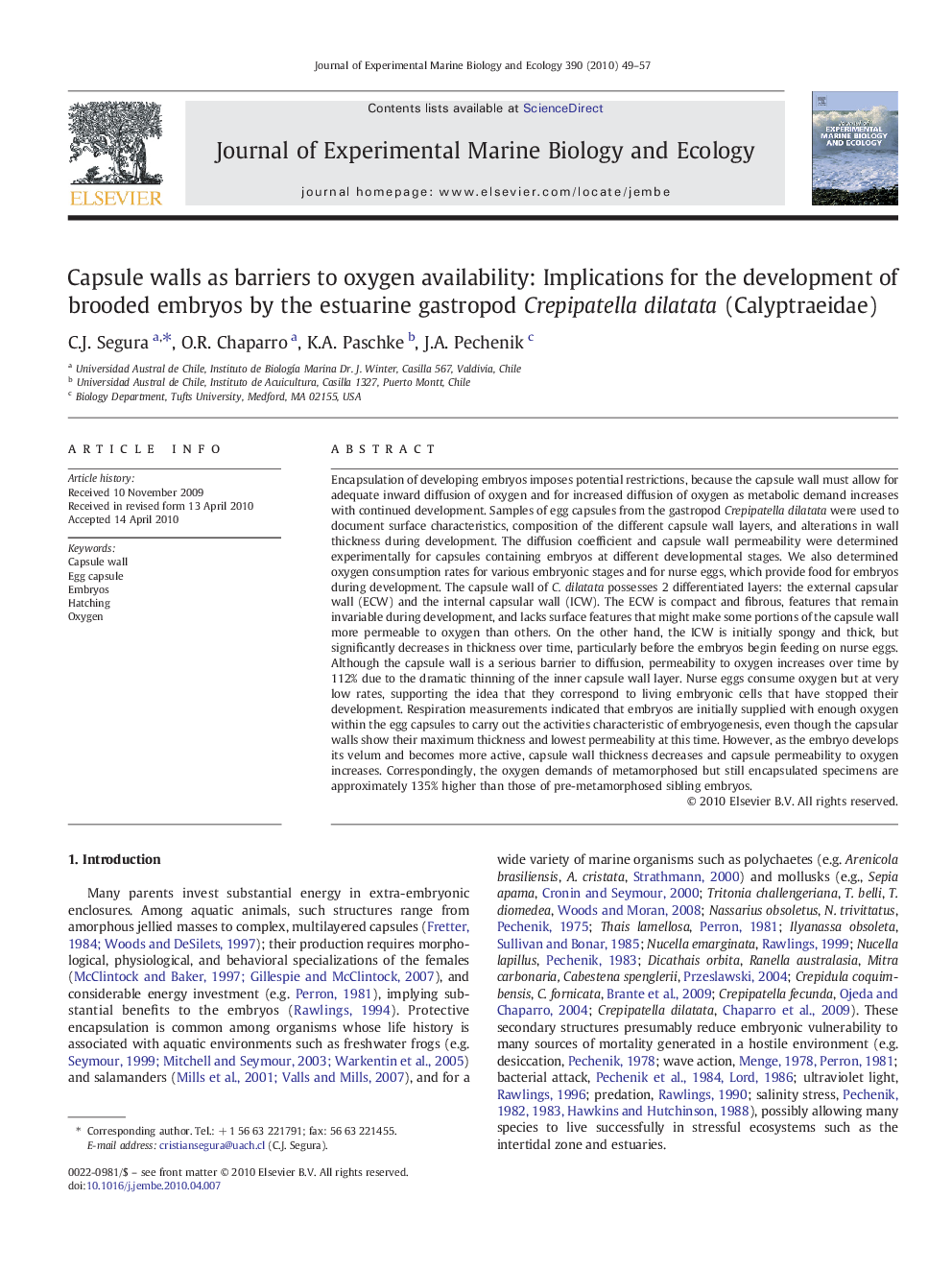| کد مقاله | کد نشریه | سال انتشار | مقاله انگلیسی | نسخه تمام متن |
|---|---|---|---|---|
| 4396628 | 1305832 | 2010 | 9 صفحه PDF | دانلود رایگان |
عنوان انگلیسی مقاله ISI
Capsule walls as barriers to oxygen availability: Implications for the development of brooded embryos by the estuarine gastropod Crepipatella dilatata (Calyptraeidae)
دانلود مقاله + سفارش ترجمه
دانلود مقاله ISI انگلیسی
رایگان برای ایرانیان
موضوعات مرتبط
علوم زیستی و بیوفناوری
علوم کشاورزی و بیولوژیک
علوم آبزیان
پیش نمایش صفحه اول مقاله

چکیده انگلیسی
Encapsulation of developing embryos imposes potential restrictions, because the capsule wall must allow for adequate inward diffusion of oxygen and for increased diffusion of oxygen as metabolic demand increases with continued development. Samples of egg capsules from the gastropod Crepipatella dilatata were used to document surface characteristics, composition of the different capsule wall layers, and alterations in wall thickness during development. The diffusion coefficient and capsule wall permeability were determined experimentally for capsules containing embryos at different developmental stages. We also determined oxygen consumption rates for various embryonic stages and for nurse eggs, which provide food for embryos during development. The capsule wall of C. dilatata possesses 2 differentiated layers: the external capsular wall (ECW) and the internal capsular wall (ICW). The ECW is compact and fibrous, features that remain invariable during development, and lacks surface features that might make some portions of the capsule wall more permeable to oxygen than others. On the other hand, the ICW is initially spongy and thick, but significantly decreases in thickness over time, particularly before the embryos begin feeding on nurse eggs. Although the capsule wall is a serious barrier to diffusion, permeability to oxygen increases over time by 112% due to the dramatic thinning of the inner capsule wall layer. Nurse eggs consume oxygen but at very low rates, supporting the idea that they correspond to living embryonic cells that have stopped their development. Respiration measurements indicated that embryos are initially supplied with enough oxygen within the egg capsules to carry out the activities characteristic of embryogenesis, even though the capsular walls show their maximum thickness and lowest permeability at this time. However, as the embryo develops its velum and becomes more active, capsule wall thickness decreases and capsule permeability to oxygen increases. Correspondingly, the oxygen demands of metamorphosed but still encapsulated specimens are approximately 135% higher than those of pre-metamorphosed sibling embryos.
ناشر
Database: Elsevier - ScienceDirect (ساینس دایرکت)
Journal: Journal of Experimental Marine Biology and Ecology - Volume 390, Issue 1, 15 July 2010, Pages 49-57
Journal: Journal of Experimental Marine Biology and Ecology - Volume 390, Issue 1, 15 July 2010, Pages 49-57
نویسندگان
C.J. Segura, O.R. Chaparro, K.A. Paschke, J.A. Pechenik,